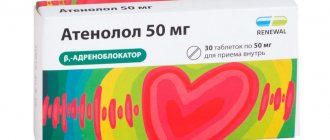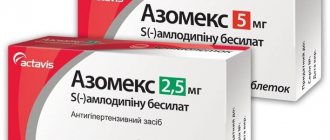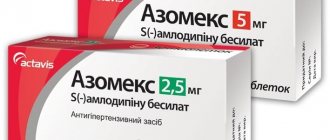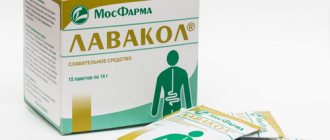Brief information about the drug
Normodipine is a blood pressure drug that belongs to the pharmacological group of calcium channel blockers. Produced by the Hungarian company Gedeon Richter.
Release form
The blood pressure medicine Normodipin is presented on the modern pharmaceutical market in tablet form, which is most convenient for use at home. The drug is sold in packages containing 10 blisters (10 tablets each).
Composition of the medicine
The main active component of the drug is amlodipine, presented in dosages of 3 mg or 10 mg. In addition, the tablets contain excipients: microcellulose, magnesium stearate, sodium carboxymethyl starch, anhydrous calcium hydrogen phosphate.
pharmachologic effect
The blood pressure drug Normodipin has a pronounced antianginal and hypotensive effect aimed at reducing blood pressure.
Normodipin tablets
Terms and storage mode
The maximum shelf life of the drug is 3 years. It is necessary to store the tablets at a temperature not exceeding +30C, in a place inaccessible to children and pets.
Conditions for dispensing from a pharmacy
You can purchase the drug in pharmacy chains only if you have an appropriate medical prescription.
Cost of tablets
The exact price of the drug depends on the dose of the main active ingredient and the number of tablets in the package. The approximate cost of Normodipin varies from 360 to 750 rubles.
Normodipine, tablets 5 mg, 30 pcs.
Manufacturer
Gedeon Richter, Hungary
Compound
Active ingredient:
amlodipine;
Excipients:
magnesium stearate;
sodium carboxymethyl starch;
calcium hydrogen phosphate anhydrous;
MCC
pharmachologic effect
Normodipine has an antianginal and hypotensive effect.
A slow calcium channel blocker, a dihydropyridine derivative, has antianginal and hypotensive effects. By binding to the S6 segments of the III and IV domains of the alpha1 subunit of the L-type calcium channel, it blocks calcium channels, reduces the transmembrane transition of calcium ions into the cell (more into vascular smooth muscle cells than into cardiomyocytes).
The antianginal effect is due to the expansion of the coronary and peripheral arteries and arterioles: in case of angina pectoris, it reduces the severity of myocardial ischemia; by expanding peripheral arterioles, it reduces peripheral vascular resistance, reduces preload on the heart, and reduces myocardial oxygen demand.
Expands coronary arteries and arterioles in unchanged and ischemic areas of the myocardium, increases the supply of oxygen to the myocardium (especially with vasospastic angina); prevents the development of spasm of the coronary arteries (including those caused by smoking). In patients with stable angina, a single daily dose increases exercise tolerance, slows down the development of angina and “ischemic” depression of the ST segment, reduces the frequency of angina attacks and the consumption of nitroglycerin and other nitrates.
It has a long-term dose-dependent hypotensive effect. The hypotensive effect is due to a direct vasodilating effect on vascular smooth muscle. For arterial hypertension, a single dose provides a clinically significant reduction in blood pressure over 24 hours (in the patient’s “lying” and “standing” position).
Orthostatic hypotension when prescribing amlodipine is quite rare. Does not cause a decrease in exercise tolerance or left ventricular ejection fraction. Reduces the degree of left ventricular myocardial hypertrophy.
It has no effect on myocardial contractility and conductivity, does not cause a reflex increase in heart rate, inhibits platelet aggregation, increases the glomerular filtration rate, and has a weak natriuretic effect. In diabetic nephropathy, it does not increase the severity of microalbuminuria.
It does not have any adverse effect on metabolism and plasma lipid concentrations and can be used in the treatment of patients with bronchial asthma, diabetes mellitus and gout.
The onset of the effect is 2-4 hours, the duration of the effect is 24 hours.
Pharmacokinetics
Suction
When taken orally, it is slowly and almost completely absorbed from the gastrointestinal tract. Eating does not affect absorption. Cmax in blood plasma is reached after 6-9 hours in both elderly and young patients. The average absolute bioavailability is 64%.
Distribution
Css of amlodipine in blood plasma is achieved after continuous use for 7-8 days.
Vd is approximately 21 l/kg, indicating predominant tissue distribution. Penetrates through the blood-brain barrier and into breast milk.
Plasma protein binding - 97%.
Metabolism
About 90% of amlodipine is biotransformed in the liver with the formation of inactive metabolites.
Removal
Amlodipine is excreted from the body in the urine (10% of the dose unchanged and 60% in the form of inactive metabolites) and in feces (20-25% in the form of metabolites). Elimination is biphasic, T1/2 averages 31-48 hours.
The total clearance of amlodiline is 7 ml/min/kg. Hemodialysis does not remove amlodipine.
Pharmacokinetics in special clinical situations
In elderly patients (over 65 years of age), the elimination of amlodipine is slower (T1/2 - 65 hours) compared to young patients, but these differences are not clinically significant.
Prolongation of T1/2 in patients with liver failure suggests that with long-term administration, the accumulation of the drug in the body will be higher (T1/2 - up to 60 hours).
The presence of renal failure in the patient does not significantly affect the pharmacokinetics of amlodipine.
Indications
- arterial hypertension (as monotherapy or in combination with other antihypertensive drugs);
- stable angina pectoris (as monotherapy or in combination with other antianginal drugs);
- vasospastic angina (Prinzmetal's angina) (as monotherapy or in combination with other antianginal drugs).
Use during pregnancy and breastfeeding
Contraindicated.
Contraindications
pregnancy; lactation period; age under 18 years (due to lack of clinical experience in use); severe arterial hypotension (systolic blood pressure less than 90 mm Hg); collapse; cardiogenic shock; clinically significant aortic stenosis; unstable angina (with the exception of Prinzmetal angina); hypersensitivity to amlodipine and other dihydropyridine derivatives. With caution: the drug should be prescribed for liver dysfunction, SSSU (severe bradycardia, tachycardia), chronic heart failure of non-ischemic etiology of functional class III-IV according to the NYHA classification, arterial hypotension, mitral stenosis, hypertrophic obstructive cardiomyopathy, acute myocardial infarction (and during 1 month after it), for elderly patients.
Side effects
Allergic reactions: infrequently - skin itching, rash (including erythematous, maculopapular rash); very rarely - urticaria, angioedema, erythema multiforme. From the genitourinary system: rarely - frequent urination, painful urination, nocturia, impotence; very rarely - dysuria, polyuria. From the cardiovascular system: often - palpitations, peripheral edema (swelling of the ankles and feet), flushing of the facial skin; infrequently - excessive decrease in blood pressure; very rarely - development or worsening of heart failure, rhythm disturbances (bradycardia, ventricular tachycardia, atrial fibrillation), myocardial infarction, chest pain, orthostatic hypotension, vasculitis. From the central and peripheral nervous system: often - headache, dizziness, increased fatigue, drowsiness; uncommon - asthenia, general malaise, hypoesthesia, paresthesia, peripheral neuropathy, tremor, vertigo, fainting, insomnia, mood lability, unusual dreams, increased excitability, depression, anxiety; very rarely - apathy, ataxia, agitation, amnesia. From the digestive system: often - nausea, abdominal pain; sometimes - vomiting, constipation or diarrhea, flatulence, dyspepsia, anorexia, dry mouth, thirst; rarely - gum hyperplasia, increased appetite; very rarely - pancreatitis, gastritis, jaundice (due to cholestasis), hyperbilirubinemia, increased activity of liver transaminases, hepatitis. From the hematopoietic organs: very rarely - thrombocytopenic purpura, leukopenia, thrombocytopenia. From the skin: rarely - dermatitis; very rarely - purpura, xeroderma, skin pigmentation disorder. From the musculoskeletal system: sometimes - muscle cramps, myalgia (with long-term use), arthralgia, back pain, arthrosis; rarely - myasthenia. From the senses: rarely - visual impairment, diplopia, conjunctivitis, eye pain, xerophthalmia, tinnitus. Other: rarely - alopecia, gynecomastia, hyperuricemia, weight gain/loss, dyspnea, nosebleeds, increased sweating; very rarely - cold sticky sweat, cough, rhinitis, parosmia, impaired taste, impaired accommodation, hyperglycemia.
Interaction
Cimetidine does not affect the pharmacokinetics of amlodipine. In in vitro studies, amlodipine does not affect the binding of digoxin, phenytoin, warfarin and indomethacin to blood proteins. A simultaneous single dose of 240 mg of grapefruit juice and 10 mg of amlodipine orally is not accompanied by a significant change in the pharmacokinetics of amlodipine. Amlodipine can be safely used for the treatment of hypertension together with thiazide diuretics, alpha-blockers, beta-blockers or ACE inhibitors. In patients with stable angina, the drug can be combined with other antianginal agents, for example, long-acting nitrates, beta-blockers or short-acting nitrates. Amlodipine can be used simultaneously with NSAIDs (especially indomethacin), antibacterial agents and oral hypoglycemic agents. It is possible to enhance the antianginal and hypotensive effect of slow calcium channel blockers of the dihydropyridine series when used together with thiazide and loop diuretics, verapamil, ACE inhibitors, beta-blockers and nitrates, as well as enhance their hypotensive effect when used together with alpha1-blockers, antipsychotics . Although negative inotropic effects have not generally been observed in amlodipine studies, some calcium channel blockers may enhance the negative inotropic effects of antiarrhythmic drugs that cause QT prolongation (eg, amiodarone and quinidine). A single dose of sildenafil in a dose of 100 mg in patients with essential hypertension does not affect the pharmacokinetic parameters of amlodipine. Repeated use of amlodipine at a dose of 10 mg and atorvastatin at a dose of 80 mg is not accompanied by significant changes in the pharmacokinetics of atorvastatin. Amlodipine with single and repeated use in a dose of 10 mg does not affect the pharmacokinetics of ethanol (drinks containing alcohol). Antiviral agents (ritonavir) increase plasma concentrations of slow calcium channel blockers, incl. amlodipine. Neuroleptics and isoflurane enhance the hypotensive effect of dihydropyridine derivatives. Calcium supplements may reduce the effect of slow calcium channel blockers. When amlodipine is used together with lithium preparations, it is possible to increase the manifestation of neurotoxicity (nausea, vomiting, diarrhea, ataxia, tremor, tinnitus). Amlodipine does not change the pharmacokinetics of cyclosporine. Does not affect the serum concentration of digoxin and its renal clearance. Does not have a significant effect on the effect of warfarin (prothrombin time).
How to take, course of administration and dosage
Orally, the initial dose for the treatment of arterial hypertension and angina pectoris is 5 mg/day. The maximum daily dose is 10 mg once. For arterial hypertension, the maintenance dose can be 5 mg/day (1 tablet of 5 mg).
In elderly patients, T1/2 of amlodipine may increase and creatinine clearance may decrease. No dose changes are required, but patients should be monitored more closely.
No dose change is required when administered concomitantly with thiazide diuretics, β-blockers and ACE inhibitors.
No dose adjustment is required in patients with renal impairment.
Overdose
Symptoms: tachycardia, marked decrease in blood pressure, excessive peripheral vasodilation (risk of developing severe and persistent arterial hypotension, including with the development of shock and death). Treatment: gastric lavage, administration of activated charcoal, maintaining the function of the cardiovascular system, monitoring indicators of heart and lung function, elevated, above head level, position of the lower extremities, control of blood volume and diuresis. To restore vascular tone, use vasoconstrictors (in the absence of contraindications to their use); in order to eliminate the consequences of blockade of calcium channels - intravenous administration of calcium gluconate. Hemodialysis is ineffective.
Special instructions
Effect on the ability to drive vehicles and operate machinery There have been no reports of the effect of the drug Normodipin® on driving a car or operating machinery. However, some patients, mainly at the beginning of treatment, may experience drowsiness, dizziness and other side effects from the nervous system. If they occur, the patient must take special precautions when driving a car and working with complex mechanisms. During treatment with Normodipin®, it is necessary to monitor body weight and sodium intake, and prescribing an appropriate diet is indicated. It is necessary to maintain dental hygiene and follow-up with a dentist (to prevent pain, bleeding and gum hyperplasia). Patients with low body weight, patients of short stature and patients with severe liver dysfunction may require a lower dose. If liver function is impaired, T1/2 of the drug may also be prolonged. Therefore, Normodipin® should be prescribed to such patients with caution. Despite the fact that discontinuation of the drug Normodipin® is not accompanied by the development of withdrawal syndrome, it is advisable to discontinue treatment by gradually reducing the dose of the drug. The effectiveness and safety of the drug in hypertensive crisis have not been established.
Release form
pills
Storage conditions
At a temperature not exceeding 30 °C
Best before date
3 years
Active substance
Amlodipine
Conditions for dispensing from pharmacies
On prescription
Dosage form
pills
Purpose
For adults as prescribed by a doctor
Indications
Hypertension, Angina
Barcode and weight
Barcode: 359426, 4605469001733, 5997001359426 Weight: 0.018 kg
Pharmacodynamics: how it affects blood pressure
Blood pressure tablets Normodipin slow down the transport of calcium through cardiomyocytes (muscular cellular structures of the heart and blood vessels). Due to the drug's ability to reduce the level of precardiac load and the tone of arterial smooth muscles, Normodipine lowers blood pressure.
The tablets have a good effect against ischemia, reducing the likelihood of developing angina attacks.
The antianginal effect of Normodipin lies in its ability to dilate coronary and peripheral blood vessels (including in cases of atherosclerosis). Reduces the degree of load on the myocardium and its need for oxygen.
The drug belongs to the group of calcium channel blockers
Pharmacological properties of the drug Normodipin
Amlodipine (3-ethyl-5-methyl ester (±)-2-[aminomethoxy)methyl]-4-(o-chlorophenyl)-1,4-dihydro-6-methyl-3,5-pyridinecarboxylic acid) - ion antagonist calcium dihydropyridine group. By blocking slow calcium channels in the cell membrane, amlodipine inhibits the entry of calcium across the cell membrane into cardiomyocytes and vascular smooth muscle cells. Under its action, the tone of the smooth muscles of blood vessels (arterioles) decreases, the peripheral vascular resistance decreases, which leads to a decrease in blood pressure. For angina pectoris, the drug increases exercise tolerance, reduces the frequency of anginal attacks and the need for nitroglycerin. The antianginal effect of amlodipine is primarily due to the expansion of peripheral arterioles and a decrease in afterload on the heart. Considering that amlodipine does not cause reflex tachycardia, cardiac function and myocardial oxygen demand are reduced. Amlodipine dilates coronary vessels in both normal and ischemic areas, which improves myocardial perfusion and oxygen supply. In patients with hypertension (arterial hypertension), amlodipine, when taken once a day, significantly reduces blood pressure in the supine and standing position for 24 hours. The effect develops gradually and is not accompanied by the development of symptomatic hypotension. Amlodipine does not have a negative effect on metabolism, does not affect the lipid spectrum of the blood plasma, and can be used in patients with diabetes mellitus, gout, and also in patients with asthma. When taken orally, amlodipine is slowly and almost completely absorbed from the digestive tract. Eating does not affect the absorption of the drug. The concentration of amlodipine in the blood plasma reaches its maximum level 6–12 hours after administration. Bioavailability is 64–80%. The volume of distribution is about 20 l/kg body weight, 95–98% of amlodipine is bound to plasma proteins. In the liver, amlodipine is biotransformed to inactive metabolites. 10% of the drug is excreted unchanged in the urine, 60% in the form of inactive metabolites. Elimination is biphasic, the half-life averages 35–50 hours. The equilibrium state is achieved on the 7–8th day of continuous use of amlodipine. Features of pharmacokinetics allow the drug to be used once a day.
Pharmacokinetics
The bioavailability of the drug is about 70-80%. The medication is absorbed through the gastrointestinal tract. Once in the liver area, it is transformed into inactive metabolites.
Normodipine reduces blood pressure within 6-7 hours from the moment of taking the tablets. The maximum concentration of the drug components in the user’s blood is observed after half a day.
The drug is eliminated from the body using the renal apparatus over a period of 35 to 50 hours.
What is Normodipin used for?
Cardiologists and general practitioners recommend drinking Normodipin for high blood pressure in patients who have the following indications for use:
- Arterial hypertension;
- Angina pectoris;
- Hypertonic disease;
- Prinzmetal's angina
The drug is also prescribed for angina pectoris occurring in a vasospastic form. It can be used as an independent medicine or as one of the components of complex therapy.
For whom is it contraindicated?
Medical specialists categorically prohibit patients from taking Normodipin with high blood pressure if they have the following clinical contraindications:
- Aortic stenosis;
- Hypotonic disease (low blood pressure);
- Individual intolerance and hypersensitivity to the components contained in the tablets;
- Shock state of cardiogenic nature;
- Angina pectoris occurring in an unstable form;
- Collapse.
The drug is not used to treat women expecting the birth of a baby, breastfeeding mothers, as well as children under the age of majority.
With particular caution, Normodipin for hypertension is prescribed to patients with diagnosed cardiomyopathy, sinus node weakness, liver dysfunction, heart failure occurring in the stage of decompensation, acute myocardial infarction, mitral stenosis.
Normodipine is contraindicated for pregnant women.
Instructions for use and dosage
Instructions for use of Normodipin recommend drinking the tablets as a whole, without crushing or chewing.
The recommended starting dose of the drug is 5 mg per day. If necessary, the daily dosage of tablets can be doubled to 10 mg.
Despite the fact that the drug does not cause withdrawal symptoms, it is recommended to complete treatment smoothly, gradually reducing the dose of Normodipine.
The duration of the therapeutic course is set by the doctor individually, depending on the exact diagnosis, the stage of the pathological process, the age and health of the patient, and the reaction of his body to the proposed treatment.
Possible side effects
When taking Normodipine for high blood pressure, you must remember that the tablets can cause the following adverse reactions:
- Irregular heart rhythm (arrhythmia);
- Excessive decrease in blood pressure;
- Dyspnea;
- Cough syndrome;
- Increased or slowed heart rate;
- Vasculitis;
- Erectile dysfunction in representatives of the stronger sex;
- Rhinitis;
- Nausea and vomiting;
- Stool disorders (diarrhea followed by constipation);
- Feeling of dryness in the mouth;
- Paresthesia of the arms and legs;
- Headache;
- Fainting;
- Hives;
- Skin itching;
- Dermatitis;
- Deterioration of visual function;
- Dyspeptic disorders;
- Attacks of dizziness;
- Tremor;
- Excessive sleepiness;
- Gastritis;
- Frequent urge to urinate;
- Thrombocytopenia (decreased blood clotting rates);
- Hair loss;
- Convulsive syndrome;
- Joint and muscle pain;
- Hyperglycemia;
- Myalgia.
Any adverse reactions that occur while taking the drug must be reported to your doctor! You may need to reduce the dosage or replace the drug with a more suitable analogue!
While taking Normodipin, vision may deteriorate
Side effects of the drug Normodipin
Headache, swelling, increased fatigue, drowsiness, nausea, abdominal pain, flushing of the facial skin, tachycardia and dizziness are noted. Rarely - intestinal dysfunction, arthralgia, asthenia, shortness of breath, dyspepsia, gingival hyperplasia, gynecomastia, impotence, frequent urination, mood lability, myalgia, itchy skin, rash, blurred vision. Extremely rarely - polymorphic erythema, jaundice, changes in the activity of liver enzymes, caused in most cases by cholestasis.
Overdose of a drug
The use of Normodipin tablets in increased dosages provokes the following alarming symptoms:
- A sharp and severe decrease in blood pressure;
- Development of hypotensive crisis;
- Rapid heartbeat (tachycardia);
- Peripheral vasodilation.
An overdose threatens the patient with going into a state of shock and even death. Therefore, at the first characteristic signs, it is necessary to call doctors, and before the specialists arrive, give the victim a gastric lavage, give a portion of sorbents, and lay him down, raising his legs above head level.
For further treatment, vasoconstrictor drugs are used, droppers or intravenous injections of calcium gluconate are given.
Overdose of the drug Normodipin, symptoms and treatment
Data is limited. Given the slow absorption of the drug, it is advisable to rinse the stomach. A significant overdose can lead to pronounced peripheral vasodilation with a significant and prolonged decrease in blood pressure. Clinically significant arterial hypotension caused by an overdose of amlodipine requires urgent measures aimed at maintaining the function of the cardiovascular and respiratory systems, including monitoring vital signs, elevated position of the lower extremities, replenishment of blood volume and diuresis control, and, if necessary, symptomatic treatment. To restore vascular tone and increase blood pressure, vasoconstrictor drugs can be used if there are no contraindications to their use. To eliminate the blockade of calcium channels, intravenous administration of calcium gluconate is indicated. Since amlodipine is highly bound to plasma proteins, dialysis is ineffective.
Interaction with other drugs
Combination with antiarrhythmic drugs enhances the negative inotropic effect.
The simultaneous use of tablets with adrenergic blockers, diuretics, and ACE inhibitors greatly enhances the antihypertensive effect of Normodipine and can cause the development of a hypotensive crisis.
Antiviral medications, on the contrary, reduce the effectiveness of this drug.
Normodipine combines well with nonsteroidal anti-inflammatory drugs, hypoglycemic, antianginal and antibacterial medications.
You should consult your doctor about the combination of Normodipine with other drugs.
Drug interactions Normodipin
Normodipine can be safely used with thiazide diuretics, beta-adrenergic blockers, ACE inhibitors, nitrates, NSAIDs, antibiotics, and oral hypoglycemic agents. The simultaneous use of Normodipine and digoxin in healthy volunteers did not change the level of digoxin in the blood serum and its clearance. Concomitant use of cimetidine does not change the pharmacokinetics of amlodipine. Normodipine does not affect the protein binding of digoxin, phenytoin, coumarin, and indomethacin. In healthy male volunteers, simultaneous use of Normodipine with warfarin did not have a significant effect on prothrombin time. Normodipine does not affect the pharmacokinetics of cyclosporine.
How to replace Normodipin
On the modern pharmaceutical market you can find and purchase the following analogues of Normodipine:
- Nimodipine;
- Emlodin;
- Lacipil;
- Amlodipine;
- Azomex;
- Amlong;
- Cordafen.
The drugs listed above have similar effects and indications, but they have their own specifics in terms of dosage, dosage regimen, and contraindications. For this reason, it is strictly not recommended to independently replace Normodipin tablets prescribed by a doctor with one of the possible analogues. If there is a need to replace the drug, you should consult on this topic with a qualified specialist who will help you choose the best option and tell you about the features of its use!
Normodipine for high blood pressure is an effective antihypertensive drug that is successfully used to treat not only hypertension, but also angina. Since the tablets have a fairly wide range of contraindications and possible adverse reactions, they can only be taken as prescribed by a qualified specialist, strictly adhering to the dosage of the medicine recommended by the doctor and the positive effects of the therapy!





